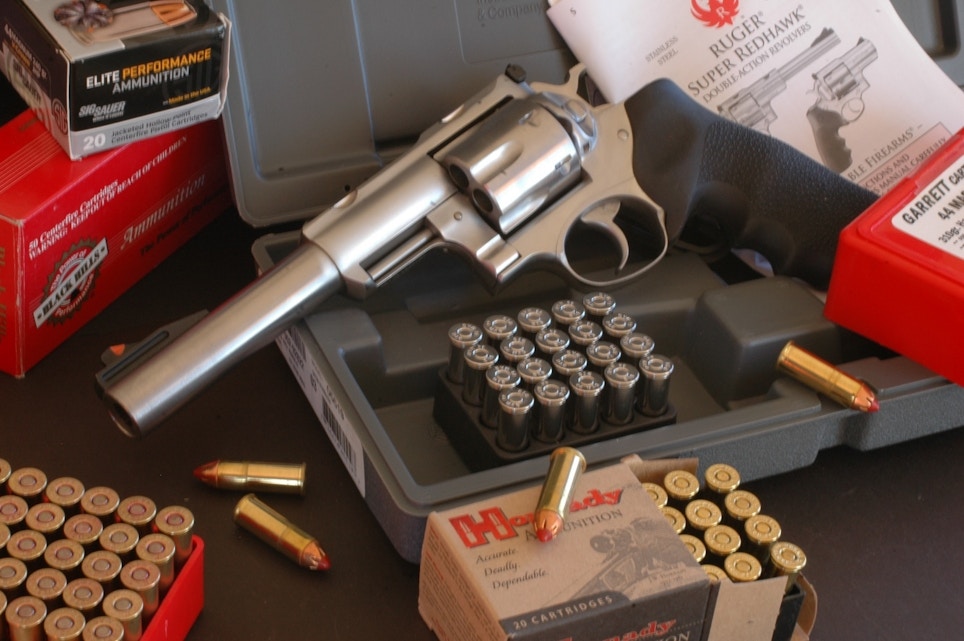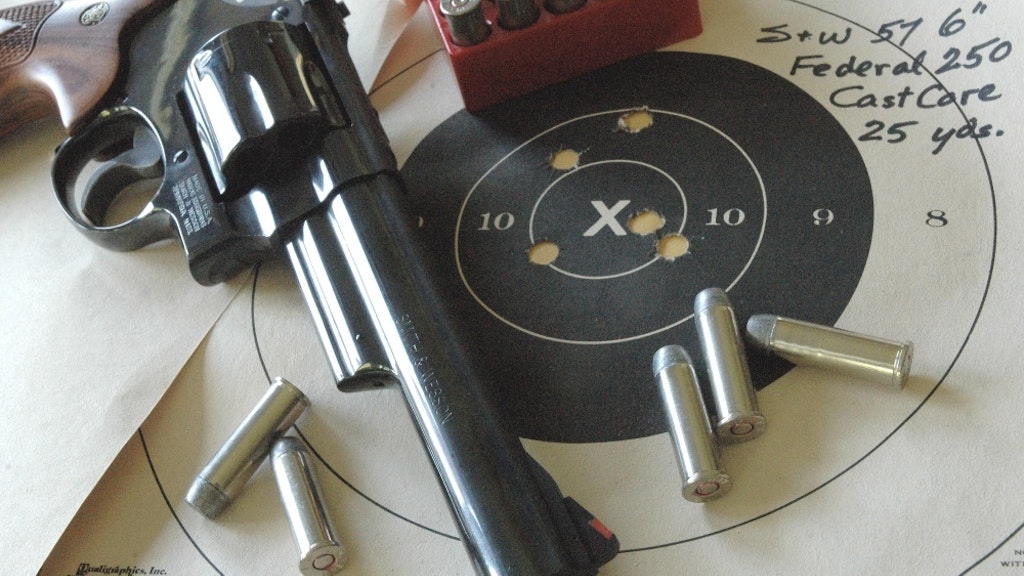Today’s handgun market is awash with concealable versions of striker-fire autos. Full-size 1911s and revolvers have eye appeal, but the best are expensive. They hold fewer rounds and can be harder for a novice or a person with small hands to shoot accurately. Most kick harder and weigh more than shooters — especially new gun-owners — want in a pistol for waistband or bed-stand.
Manufacturers are as pleased as retailers. Multiple-axis CNC machines can quickly carve metal parts for striker-fired autos. Polymer works for components that were once chewed from steel. Assembly is easy because these pistols were designed to come apart and go back together on garage benches.
Still, full-size autos in .40, 10mm and .45 ACP, and revolvers in .357, .41 and .44 Magnum, offer more than historical heft and the feel of “real guns.” They’re useful as back-up in bear country.
On August 12, 1977, helicopter pilot Ed Spencer set his chopper down on an Alaskan ridge to let Cynthia Dusel-Bacon off for her day’s work as a U.S.G.S geologist. Soon thereafter, on the trail, Cynthia spotted a bear as it rose from nearby brush. She yelled and waved her arms. The bear stared back. Cynthia had no firearm. When the animal disappeared, she moved above the trail. Suddenly the bear leaped from nowhere and struck her down. She willed herself to remain still as it bit into her right shoulder and shook her. When she reached for the radio in her backpack, the bear shredded her arm. Then she heard its teeth “crunching on my skull.” As the animal pulled her into the brush, her pack ripped, exposing the radio. She managed to key it. “Ed! Come quick!” she screamed. “I’m being eaten by a bear!”
Relayed from camp 80 miles off, that call was Cynthia’s salvation. But she would lose both arms in surgery. The bear believed to have mauled Cynthia was shot. It was not a giant grizzly but a 175-pound black bear. Studies have tallied as many attacks from black bears as from grizzlies.
Any bear attack is a rare event. Usually the person surprises the animal or is perceived as a threat to cubs or to a carcass the bear claims. The beast that maimed Cynthia evidently saw her as prey.
Avoiding bears is a good idea. Running from a bear is not, as it can trigger a predatory response, and bears sprint at 40 mph. Playing dead, you’re no longer a threat, but if you were targeted as prey, you become dinner.
For decades, outfitter Ron Dube hosted hunters where grizzlies abound. He never shot a bear. “I left them alone. Confronted, I didn’t show fear,” he said. “When a grizzly followed its nose to camp supper, I stood, yelled and waved him off. Once a client and I came upon a big griz on a carcass. Unaware of us, it paced about, growling, bristling, asserting ownership. A dangerous bear. We left quietly, right away.”
Bear spray, well directed, can stop an aggressive bear. But I find a spray can be awkward to aim and not as quick to deploy as a handgun. Speed often matters — though hitting the bear with a bullet may not. In Wyoming wilderness, a guide from a camp I shared barely had time to fire his .357 in front of a bear that charged his clients from behind. The sow dashed past the men on one side, her half-grown cub on the other. That week, a Montana guide was killed by a grizzly that came fast as he was field-dressing an elk. The report indicated his pistol was not within easy reach. He had no chance to fire it.
Selling Protection
If you peddle firearms, you know sales come easier when customers have use in mind. But “use” may not mean frequent firing. As with handguns bought for home protection, a pistol for field carry in bear country may see little action beyond a zero check. Indeed, because it kicks harder and is more costly to fire than a 9mm, a pistol with the muscle to turn a bear may be shot rarely. Unlike bear spray, however, a handgun is something to admire, a pleasure to carry even if it’s never needed. That’s why people who hunt with rifles bring big pistols along and why enthusiasts own several 1911s or big-bore revolvers.
Given the current stampede to striker-fired autos, a gun store can easily commit its annual budget to small, angular look-alikes. But a powerful pistol in the display case instantly draws the eye.
A classic bear-country backup is S&W’s Model 29 revolver. Alaska’s guides hailed it soon after the .44 Magnum’s 1956 debut, long before Eastwood became Dirty Harry. But a brown bear outfitter told me this tale: “One bear solidly hit by a rifle bullet struggled into alders. The client declined to follow, so I took .44 in hand. A few steps on, a wall of bear rose up in my face. The beast flattened me. I emptied all six into him as he ran me over, wanting out. My shots had no visible effect. He expired shortly, probably from the rifle wound. No pistol has the punch to reliably stop a big bear unless the bullet destroys brain or spine. In the lightning-quick fury of a charge, such hits are hard to make.”
There are frothier rounds than the .44 Magnum. S&W offers X-Frame DA revolvers in .460 and .500 S&W. But these weigh 72 ounces, twice as much as an L-Frame .357 or a mid-weight 1911. Freedom Arms lists its exquisite SA Model 83 in .454 Casull and .500 Wyoming Express. At 53 ounces, this too is a hunting handgun. A backup for all-day carry shouldn’t exceed, say, 40 ounces with a 4- or 5-inch barrel. All-steel 1911s qualify. S&W N-Frame .357, .41 and .44 Magnums don’t!
Autoloaders get more punch with the 10mm than with the .45 ACP. Introduced in the Bren Ten pistol in 1983, the 10mm is regaining traction it once lost to the .40 S&W. SIG offers it in its 220. Dan Wesson, Kimber, Ruger and Springfield Armory chamber 1911s for it. It’s even showing up in revolvers: S&W’s 42-ounce Model 610 and Ruger’s 38-ounce GP-100. Federal’s 180-grain Trophy Bonded bullet at 1,275 fps carries 650 ft./lbs. Just as lethal: Hornady’s 180-grain XTP and Winchester’s 180-grain Defender loads.
Among 10mms, Springfield’s XD-M Elite stands apart, a striker-fired auto with 3¾-inch barrel. It weighs 28½ ounces with a Hex Firefly red-dot sight. So equipped, it lists for less than $850.
How would this polymer-frame auto compare with a 10mm 1911 or a powerful DA revolver in a bear crisis? Its 11-shot magazine has an edge. That double stack makes the grip easy to hold and comfy in recoil. Ambidextrous controls are a plus. And the XD-M Elite weighs a half-pound less than a steel 1911.
My 10mm XD-M cycles without fault. Its balance puts it naturally on target. The Hex Dragonfly red-dot sight, a treat for aging eyes, hunkers low for fast aim. Trigger pull is a consistent 5¼ pounds. Out of the box from 25 yards, four of five bullets stayed inside 1.4 inches. Of course, I nudged the last an inch farther out! Recoil? About like a .45’s.
Whatever the backup pistol, fast, sure handling upstages the measure of 25-yard groups.
Field Carry
Where a pistol rides and how efficiently it can be drawn can decide the outcome of a bear encounter.
Unlike a hunting gun, in hand or secured until drawn for a carefully considered shot, a backup gun must come to palm instantly from any body position, maybe during a scramble over deadfall, as a bear delivers a haymaker or when going fetal suddenly makes sense! Until then, it must be shielded from weather and stay with you.
Because holsters are important, a selection belongs wherever handguns are sold. Without a suitable holster, many pistols go home in a box, so peddling holsters can be profitable even without gun sales. List prices for production-line Kydex and leather holsters and rigs range, roughly, from $40 to $300. Stocking for popular pistols, with an easy-order scheme for others, you can serve any customer.
I like leather. As a wildlife agent, I once carried my S&W 66 in a Milt Sparks hip holster. Now it rides in Galco’s Combat Master, which better secures it. Both holsters give the revolver a butt-forward cant. My hand catches it naturally in a firing grip.
A 1791 OWB hip holster cradles my Springfield Armory XD-M 10mm Elite. Of heavy steer-hide and beautifully contoured, it’s slotted for the beefiest belts and shaped to hug the waist. It puts the trigger 1¼ inches above belt-line, grip raked forward. My Firefly red-dot sight clears the holster mouth; my big-knuckled fingers have room to get a firing grip.
Trail miles remind me when my belt suspends a pistol heavier than 30 ounces, and hunting coats that overhang a belt holster impede a hip draw, especially if you’re on the ground. For 1911s and big-bore revolvers, I prefer a chest carry. It distributes a pistol’s weight where my body best bears up under backpacks many times heavier! Also, if a bear is too near or spotted too late to risk immediate exit, easing my hand slowly to a chest holster imparts less change in my body’s profile and less charge-inducing motion than lifting a coat to draw from a belt or shoulder holster. Want to pull off a mitten? Your teeth are inches above the pistol. A bear with mayhem in mind requires no delay. Most coats are easy to open from the top. A chest holster is accessible when they’re just partly undone. If you’re late and batted to earth, your hands naturally come chest-ward to shield vitals.
For full-size backup pistols, Galco’s Great Alaskan chest holster is my favorite chest rig. It has a flexible, lightweight harness properly broad across the shoulder, with a pinch-release polymer snap on a nylon torso tag. Closely and precisely stitched, the holster leather is stiff and molded to fit specific guns. A leather retention strap with a snap allows cocked-and-locked carry. The Great Alaskan chest holster is available for pistols and revolvers, with matching pouches for magazines and loose ammo.
Galco offers many styles of leather holsters, hand-molded to fit myriad revolvers and autos. Most of my holsters are Galcos. Oddly enough, a Slovakian gun-leather firm goes by the name Falco. The Falco chest rig I’ve used is finely crafted. It fits my 1911 like the proverbial glove. Falco takes custom orders and responded promptly to mine.
Not everyone prefers leather. Sweat makes it smell bad. Acids and moisture in leather cause rust on pistol steel. Petroleum oils deter rust but weaken leather over time. So Galco and other holster-makers use Kydex, too. It’s durable and economical. It can be closely fitted to specific pistols and won’t mar them. Some shooters like the in-and-out “click” of high-quality Kydex holsters.
Selling either handgun or holster as mere insurance, you sell it short. Unlike bear spray, both have value beyond utility. They please customers before and after travels where bears live!








